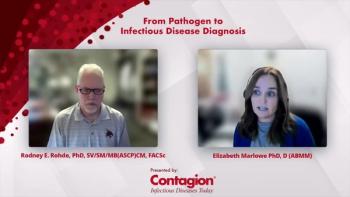
Microbiota-Based Therapy Shows Promise for C difficile Sufferers
One dose of microbiota-based therapy proved more effective than 2 at wiping out recurrent C. difficile infection.
Despite all the good that they do, antibiotics can have some nasty side effects—namely, wiping out an individual’s beneficial gut bacteria along with the bad bugs. When this happens, a vulnerable person can contract Clostridium difficile, or C. diff. This infection, common among hospital patients—particularly elderly ones—causes profuse diarrhea and general gastrointestinal distress. The standard treatment is another antibiotic, usually vancomycin, fidaxomicin, or metronidazole. However,
One development over the past few years has been a procedure known as
The phase 2B randomized, double-blinded study involved 127 adult patients enrolled at 21 different medical centers in the United States and Canada. Every patient had experienced 2 or more recurrences of C. diff infection. Participants were assigned to 1 of 3 groups: Group A was given 2 doses of RBX2660, Group B was given 2 doses of placebo, and Group C was given 1 dose of RBX2660 and then 1 dose of placebo. All of the treatments and placebos were offered in a single-dose enema bag.
The main objective of the study was to confirm that Group A was more successful in avoiding a C. diff recurrence than Group B. However, this did not happen. Group A saw a 61% efficacy rate and Group B saw a 45% efficacy rate, a statistically insignificant difference. Interestingly, Group C achieved a 67% rate of success. “That was the difference between statistically significant and not significant,” Erik Dubberke, MD, MSPH, associate professor of medicine at Washington University in St. Louis and the lead author of the study, told Contagion ®.
According to Dr. Dubberke, the trial was designed to evaluate the effects of 2 doses of RBX2660 that were spaced 1 week apart. Although the second dose was allowed to be given earlier than 1 week after the first, the study’s administrators deemed 13 participants failures when they experienced a recurrence of diarrhea after receiving just the first dose, potentially affecting the power of the study.
“The two main takeaways from this study were to move forward with a single dose, not 2 doses, and to use a higher treatment success rate in the placebo arm when doing the power calculations,” said Dr. Dubberke. “The 2-dose design likely led to a lower threshold to restart C. diff treatment if the patient developed diarrhea prior to the second dose, thus resulting in a patient being considered a treatment failure versus waiting for C. diff resting to come back to determine if the patient actually was a treatment failure. Using a more realistic treatment success rate in the placebo arm should ensure the study is adequately powered to demonstrate superiority against placebo,” he said.
Dr. Dubberke said that the scientific community needs to be working toward getting microbiota-based therapies approved by the FDA, both for safety reasons and for increased patient access. “If a clinician feels a patient with recurrent CDI will benefit from a microbiota-based product, the first step should be to refer the patient to a center that is enrolling patients into clinical trials of microbiota-based products,” he said.
Laurie Saloman, MS, is a health writer with more than 20 years of experience working for both consumer- and physician-focused publications. She is a graduate of Brandeis University and the Medill School of Journalism at Northwestern University. She lives in New Jersey with her family.
Newsletter
Stay ahead of emerging infectious disease threats with expert insights and breaking research. Subscribe now to get updates delivered straight to your inbox.

















































































































































































































































































